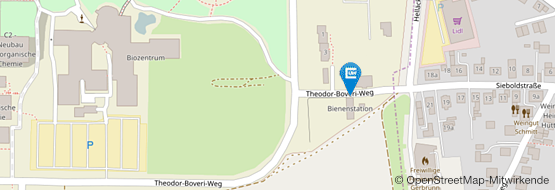Beetz lab - Spatial memory in insects
Aside from humans, honeybees are so far the only known species that communicate spatial information to conspecifics. After arriving at the hive from a successful foraging bout, a forager performs a waggle dance that signals distance and direction to the food source. Conspecifics are recruited to follow the dancer and seek to extract the spatial information that are relevant to localize the food source. As the waggle dance occurs inside the dark hive, different sensory modalities must be involved to process spatial information than outside the hive where visual cues are omnipresent and used for spatial navigation during flight. One of our research questions is how distance and directional information are processed in these two behavioral contexts, namely inside and outside the hive. To answer this question, we use diverse techniques such as behavioral, anatomical, and neurophysiological approaches.
The waggle dance gives us a unique glimpse into the bee’s spatial mind because dancing bees retrieve and recruits acquire spatial memory at this particular moment in time. With recently developed tetrode recordings (extracellular recordings) from freely behaving bees, our group studies brain and behavior in concert with the long-term goal to reveal neuronal mechanisms underlying the space representation, including spatial memory.
The bee’s habitat is enriched with terrestrial objects that may serve as landmarks to guide the bees. To what extent the visual landscape is learned during the foraging phase of a bee’s lifecycle and may influence vector-based navigation remains unclear. We therefore want to study how visual cues, including objects are learned and used in the context of visual place learning.
- How are spatial information from the waggle dance integrated into the compass network of the honeybee brain?
- Which neuronal mechanisms underly insect spatial memory?
- How is space represented in the brain of freely foraging bees?
- How do insects sense gravity?
- What is the influence of the visual landscape to set a course when a honeybee leaves the hive?
-
How is the visual panorama including landmarks processed in the insect brain?
-
Monarch butterflies memorize the spatial location of a food source. . In Proceedings of the Royal Society B, 290, p. 20231574. 2023.
- [ URL ]
-
Neural representation of goal direction in the monarch butterfly brain. . In Nature Communications, 14(1), p. 5859. 2023.
- [ URL ]
-
Flight-induced compass representation in the monarch butterfly heading network. . In Current Biology, 32(2), pp. 338–349.e5. 2022.
- [ URL ]
-
Temporal tuning in the bat auditory cortex is sharper when studied with natural echolocation sequences. . In Scientific Reports, 6, p. 29102-. The Author(s), 2016.
- [ URL ]
-
Topographic organization and possible function of the posterior optic tubercles in the brain of the desert locust Schistocerca gregaria.. . In Journal of Comparative Neurology, 523(11), pp. 1589–1607. 2015.
- [ URL ]




